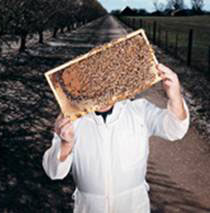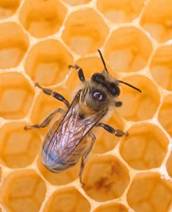|
from AgricultureIMVA Website
A quick federal survey indicates a heavy bee die-off this winter of 2010, while a new study shows honeybees’ pollen and hives laden with pesticides. Scientists are concerned because of the vital role bees play in our food supply. About one-third of the human diet is from plants that require pollination from honeybees, which means everything from apples to zucchini.
One-third of those surveyed had trouble
finding enough hives to pollinate California’s blossoming nut trees,
which grows the bulk of the world’s almonds.
It is thought that honeybees annually
pollinate On their travels, bees transfer pollen from plant to plant, flower to flower, fertilizing the blossoms and allowing them to set fruit.
This ancient partnership of pollinator
and plant is essential to life as we know it. One-third of the food
we eat comes from crops that need animal pollinators, a role often
filled by bees but sometimes by butterflies, beetles, birds, or
bats.
In the last few years beekeepers have been getting the shock of their lives seeing hundreds of millions of their bees literally disappearing. Beekeepers go out to open their hives and find them empty. Bees are flying off in search of pollen and nectar and simply not returning to their homes, they vanish without a trace.
Researchers say the bees are dying in
the fields, perhaps becoming exhausted or simply disoriented and
eventually falling victim to the cold. Researchers have labeled this
affliction “colony collapse disorder.”
Farmers across North America have been
blitzing their Greg Ciola wrote in his book GMOs, Beware of the Coming Food Apocalypse,
Safe pastures where bees can forage
without being In the UK, there have been “a few but significant examples” of what experts call the “Marie Celeste phenomenon” – colonies abandoning hives altogether leaving no evidence of what caused their disappearance.
Greece, Italy, Poland, Portugal, and Spain have also had their bouts with “colony collapse disorder.”
Honey bees are responsible for approximately one third of the United States crop pollination including almonds, peaches, soybeans, apples, pears, pumpkins, cucumbers, cherries, raspberries, blackberries and strawberries. Investigators are exploring a range of theories, including viruses, a fungus and poor bee nutrition.
They are also studying a group of pesticides that were banned in some European countries to see if these are somehow affecting the bees’ innate ability to find their way back home.
It has been noted that to give bees
energy while they are pollinating, beekeepers now feed them protein
supplements and a liquid mix of sucrose and corn syrup.
There are no tell-tale bee corpses
inside colonies or out in front Experts are speculating that it may be the consequence of a new infection, or of several diseases simultaneously, leading to a fatally compromised immune system.
It is also possible that severe stress brought on by crowding, inadequate nutrition or perhaps the combined effects of prophylactic antibiotics and miticides sprayed by beekeepers to ward off infections.
Another particularly sad possibility is that accidental exposure to a new pesticide may cause non-lethal behavioral changes that interfere with the ability of honeybees to orient and navigate.
Brain-damaged foraging bees may simply
get lost on their way home and starve to death away from the hive.
Honeybees contribute to our food chain
in more
The following mercury levels were found in bees from the contaminated area: heads 0.029-0.385 mg/kg, thorax 0.028-0.595 mg/kg and abdomen 0.083-2.255 mg/kg.
Mercury levels in samples from uncontaminated areas ranged from 0.004 to 0.024 mg/kg in the heads, from 0.004 to 0.008 mg/kg in the thorax and from 0.008 to 0.020 mg/kg in the abdomen.
In honey samples from the contaminated and uncontaminated areas mercury levels ranged from 0.050 to 0.212 mg/kg and from 0.001 to 0.003 mg/kg, respectively.[1]
Researchers have also demonstrated heavy
metal accumulation in honey suggesting that honey may be useful for
assessing the presence of environmental contaminants.[2]
Researchers believe that it is likely that changes in muscle gene expression, biochemistry, metabolism and functional capacity may be driven primarily by behavior as opposed to age, as is the case for changes in honey bee brains.[3]
Even at low levels of exposure, mercury can permanently damage the brain and nervous system and cause behavioral changes in people.
Mercury is a harsh neurological
poison that affects neurological tissues throughout the animal
kingdom and it is very possible that it is affecting the sensitive
brains of honey bees.
When gilial progenitor stem cells in the
brain were exposed Power plants are the largest unregulated source of mercury emissions, releasing 48 tons of mercury into the air annually in the United States alone.
Oil, fertilizers, pesticides and the countless other chemicals, byproducts and debris that enter our water, air and land continually afflict species worldwide and produce damaging, long-lasting effects.
Mercury is however one of the most
prevalent and powerful poisons, and it manages to infiltrate
everything.
Mercury pollution is making its way into
nearly
The theory that cell phone radiation
seriously interferes with bees’ ability to navigate through the air
is just an example as would be increased levels of radiation
pollution (uranium oxide) from the recent use of depleted uranium
weapons on distant battle fields. Human activity is poisoning the
bees as we poison ourselves. Freud would probably feel vindicated
with his death principle.
There is doubt that he actually said
that, and certainly it is an exaggeration but there’s a grain of
truth to the apocryphal quote, and the apocalyptic overtones aren’t
far off the mark.
Extinction of a species doesn’t just affect the group that disappears – it tends to alter more.
What is killing one species after
another on our world is threatening us whether we realize it or not.
Notes
|


